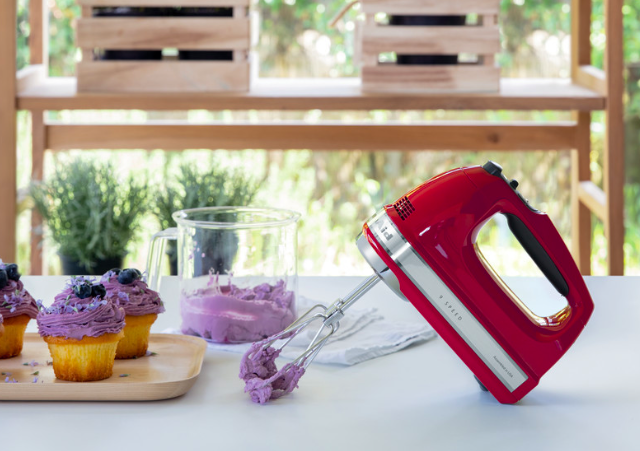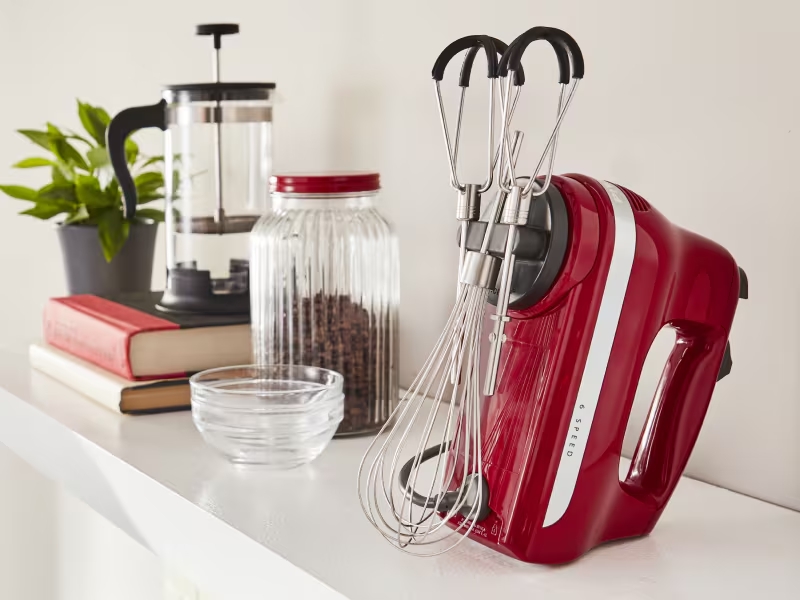Ever been there? You’re carefully adding flour to your bowl, you hit the power button on your old hand mixer, and poof—a cloud of white dust erupts, blanketing your countertop, your clothes, and your spirit. We’ve all had those moments. But what if I told you that the secret to a cleaner, quieter, and more controlled baking experience isn’t about your technique, but about the engine humming inside your mixer? Let’s talk about What Is A Dc Motor Hand Mixer and why it might just be the game-changer your kitchen has been waiting for.
For years, the trusty hand mixer has been a staple in home kitchens, a reliable sidekick for everything from fluffy whipped cream to stiff cookie dough. But as technology evolves, so does this humble appliance. The shift from traditional AC motors to modern DC motors is one of the most significant upgrades in recent memory, turning a good tool into a truly great one.
A Quick Spin Through Hand Mixer History
Before we dive into the nuts and bolts, let’s take a quick trip back in time. The earliest electric hand mixers, which became popular in the mid-20th century, were built around AC (Alternating Current) motors. They were revolutionary for their time, saving countless arms from the tedious task of whisking by hand. They were powerful, sure, but also notoriously loud, heavy, and often had a “zero to sixty” approach to speed, making delicate tasks a bit of a gamble.
Enter the modern era. As our gadgets got smarter, so did our kitchen appliances. Engineers looked for ways to make hand mixers lighter, more efficient, and more responsive. The solution? The DC (Direct Current) motor.
So, What is a DC Motor Hand Mixer, Really?
A DC motor hand mixer is a kitchen appliance that uses a Direct Current motor instead of a traditional Alternating Current (AC) motor. This results in a lighter, quieter, and more energy-efficient device that offers superior speed control, especially at lower RPMs.
Think of it this way: an old AC motor is like a classic muscle car—it’s loud, powerful, and gets the job done with brute force. A DC motor, on the other hand, is like a modern electric vehicle—it’s whisper-quiet, incredibly efficient, and delivers precise, responsive power exactly when and where you need it. The difference in the user experience is night and day.
AC vs. DC Motors: The Kitchen Showdown
So what’s the big deal? Why should you care about the type of motor in your hand mixer? Here’s a simple breakdown:
- AC (Alternating Current) Motors:
- The Old Guard: This is the technology found in older and many budget-friendly mixers.
- Performance: Generally heavier and much louder during operation. They often struggle to maintain consistent torque at low speeds.
- Speed Control: Can be jerky. The jump from speed 1 to speed 2 can be dramatic, leading to those infamous flour explosions.
- DC (Direct Current) Motors:
- The Modern Contender: The technology behind premium and modern hand mixers.
- Performance: Significantly quieter, lighter, and more energy-efficient. They provide excellent, consistent torque across all speed settings.
- Speed Control: Incredibly smooth and precise. Many feature a “soft start” function that gradually ramps up the speed, keeping your ingredients in the bowl.
Key Features to Look for in a DC Motor Hand Mixer
Now that you know the “why,” let’s get into the “what.” If you’re shopping for a new mixer, here are the key features powered by DC motor technology that you should be looking for.
Power and Performance (It’s Not Just About Watts!)
With older AC mixers, high wattage was often the main indicator of power. But with a DC motor hand mixer, efficiency is the name of the game. A 100-watt DC motor can often outperform a 250-watt AC motor because it uses energy more effectively to generate torque—the actual twisting force that powers through thick brownie batter or dense cookie dough. Don’t be fooled by a lower wattage number; look for brands known for their DC motor performance.
Speed Settings and Soft Start
This is where DC motors truly shine. Because they offer more precise electronic control, you’ll often find mixers with 7, 9, or even more speed settings. Most importantly, look for a soft start feature.
“For a home baker, a mixer with a soft start is a lifesaver. It gives you the confidence to add dry ingredients without redecorating your kitchen in a fine layer of flour. It’s the kind of thoughtful design that separates a good tool from a great one.” – Chef Isabella Rossi, Pastry Consultant
Attachments and Accessories
A great motor deserves great tools. Most quality mixers will come with a standard set of accessories:
- Turbo Beaters: Your go-to for general mixing, creaming butter and sugar, and cake batters.
- Whisk: Perfect for whipping egg whites into stiff peaks or creating light and airy whipped cream.
- Dough Hooks: Ideal for kneading small batches of bread or pizza dough. The consistent torque of a DC motor is particularly good for this task.
Corded vs. Cordless Convenience
The high efficiency of DC motors has paved the way for powerful and long-lasting cordless hand mixers. This is a freedom you don’t know you need until you have it! No more stretching a cord across the kitchen or fighting for a free outlet.
- Corded: Offers consistent, unlimited power. Great if you do a lot of marathon baking sessions.
- Cordless: Offers unparalleled freedom and convenience. Perfect for quick tasks, small kitchens, or moving from the counter to the stovetop. Modern models hold a charge surprisingly well.
Getting the Most Out of Your New Kitchen Gadget
Owning a great tool is one thing; knowing how to use it is another. Here’s how to make your DC motor hand mixer your most valuable kitchen player.
A Beginner’s Guide to Using Your Hand Mixer
- Secure the Attachments: Before plugging it in, insert the correct beaters into the slots. You should hear a distinct “click” when they lock into place.
- Start in the Bowl: Always place the beaters into your ingredients before turning the mixer on.
- Embrace the Soft Start: Begin on the lowest speed setting. The mixer will gently ramp up, preventing splatters.
- Move It Around: Don’t just stay in the center. Move the mixer around the bowl in a circular or figure-eight motion to ensure everything is evenly incorporated.
- Stop Before Removing: Always turn the mixer completely off before lifting the beaters out of the bowl.
Pro Tips and Tricks from Our Kitchen
- Use a Deep Bowl: A high-sided bowl is your best defense against stray splashes, no matter how good your mixer’s soft start is.
- Temperature Matters: For the fluffiest whipped cream, chill your bowl and beaters in the freezer for 15 minutes beforehand. For creaming butter and sugar, make sure your butter is at room temperature for the smoothest results.
- The “Lift and Fold” Motion: When incorporating delicate ingredients like whipped egg whites, use the lowest speed and a gentle up-and-down motion to mimic folding by hand.
Hand Mixer vs. Stand Mixer vs. Whisk: When to Use What?
Is a hand mixer always the right tool for the job? Not necessarily. Here’s a quick guide:
- Hand Whisk: Best for small, quick tasks like scrambling a few eggs, mixing a vinaigrette, or when you want maximum control over aeration.
- DC Motor Hand Mixer: The ultimate versatile tool. Perfect for everyday tasks like making cookies, cakes, mashed potatoes, and whipped cream. It’s quick to set up, easy to clean, and simple to store.
- Stand Mixer: The heavy-duty workhorse. Use this for large batches, heavy bread doughs, or recipes that require long, continuous mixing times, like marshmallows or Italian meringue.
Keeping Your Mixer in Tip-Top Shape: Cleaning and Care
Proper care will ensure your mixer lasts for years. Luckily, it’s incredibly easy.
- Unplug First! This is the most important step. Always unplug the mixer before cleaning or ejecting the beaters.
- Eject the Beaters: Press the ejector button to release the attachments. Most beaters, whisks, and dough hooks are dishwasher-safe (check your manual to be sure!).
- Wipe Down the Body: Use a damp cloth to wipe down the main body of the mixer. Never, ever submerge the motor housing in water.
- Store Smartly: Wrap the cord loosely around the mixer body or use the provided storage case to keep everything neat and tidy.
Frequently Asked Questions (FAQ)
Are DC motor hand mixers more expensive?
Generally, they tend to be priced slightly higher than basic AC motor models, but the investment is well worth it for the improved performance, quieter operation, and better user experience. You can find excellent options across various price points.
Can I knead bread dough with a DC motor hand mixer?
Yes, for small batches of soft dough. The included dough hooks and the consistent torque of a DC motor are designed for this. For larger or stiffer doughs, a stand mixer is still the better choice to avoid overworking the hand mixer’s motor.
How do I know if a hand mixer has a DC motor?
Manufacturers are usually proud of this feature! Look for it in the product description on the box or online. Key phrases to watch for include “DC motor,” “quiet operation,” “lightweight,” and “soft start.”
What’s the biggest advantage of a cordless hand mixer?
Freedom! The ability to mix anywhere without being tethered to an outlet is the primary benefit. Thanks to efficient DC motors, modern cordless models are powerful enough for most tasks and hold a charge for multiple baking sessions.
Is a DC motor hand mixer powerful enough for thick batters?
Absolutely. In fact, this is where they excel. The high-torque nature of a DC motor allows it to maintain a consistent speed and power through dense cookie dough or thick brownie batter without straining.
The Final Whisk
So, what is a DC motor hand mixer? It’s more than just a piece of technology; it’s an upgrade to your entire baking process. It’s the difference between a loud, messy chore and a quiet, controlled, and enjoyable creative outlet. By offering a lighter weight, whisper-quiet operation, and unparalleled precision, it puts the joy back into mixing. Whether you’re a seasoned baker or just starting, investing in a quality DC motor hand mixer is a decision your future self—and anyone who gets to taste your creations—will thank you for.
Happy baking! We’d love to hear about your own hand mixer experiences in the comments below.
